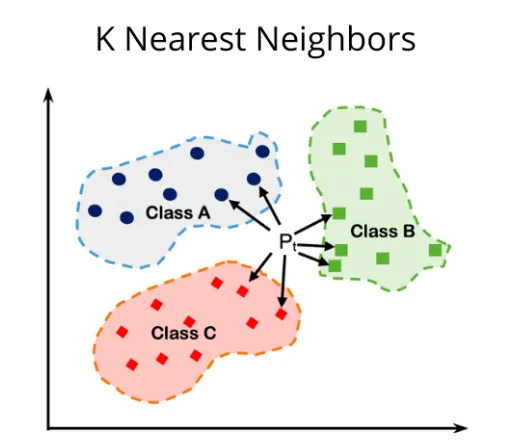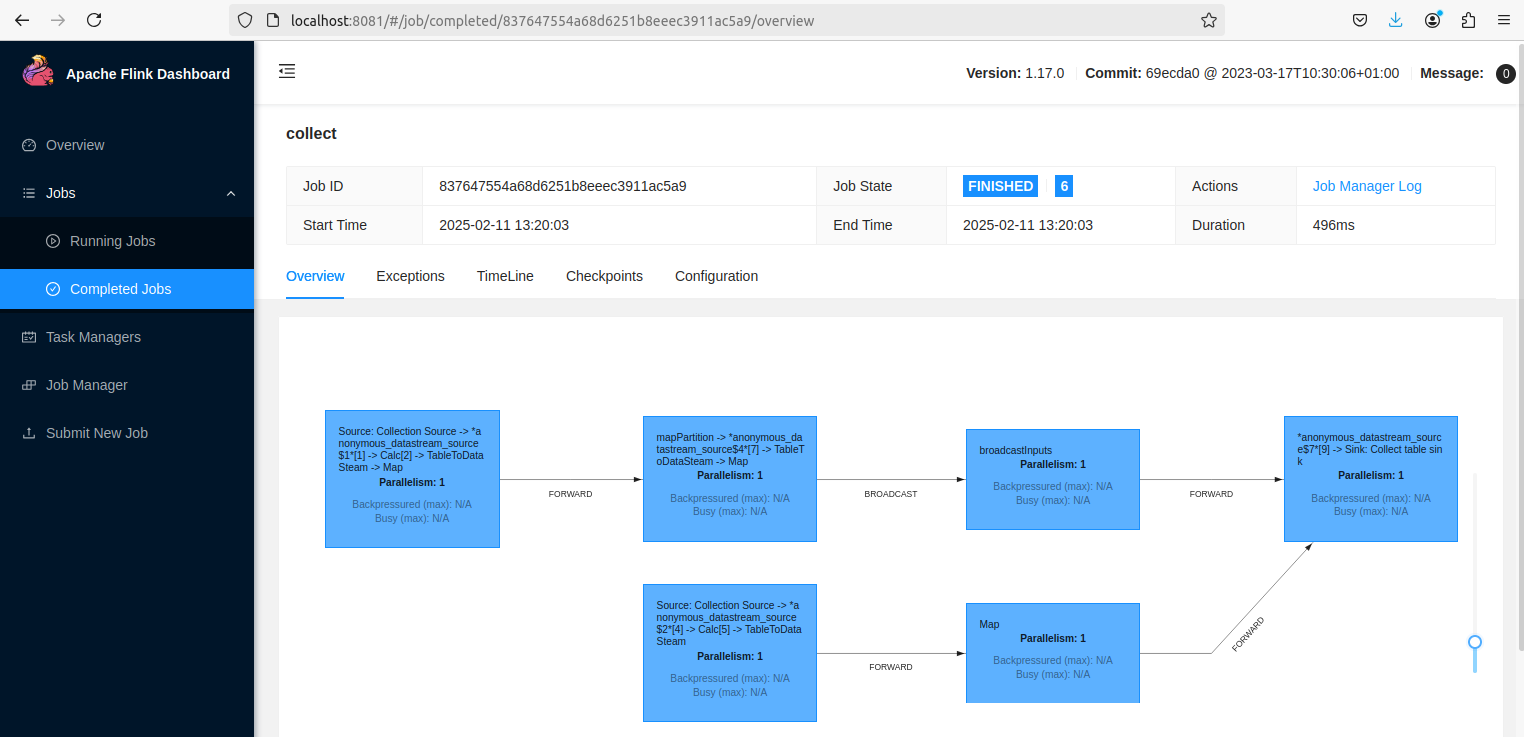Classification/KnnExample
Machine Learning
K-Nearest Neighbor
The Example:
classification/KnnExample
Description

K Nearest Neighbor(KNN) is a classification algorithm. The basic assumption of KNN is that if most of the nearest K neighbors of the provided sample belong to the same label, then it is highly probable that the provided sample also belongs to that label.
Prerequisites
- JDK 11
- Maven 3.9.9
- Flink 1.17.0
KnnExample.java
/*
* Licensed to the Apache Software Foundation (ASF) under one
* or more contributor license agreements. See the NOTICE file
* distributed with this work for additional information
* regarding copyright ownership. The ASF licenses this file
* to you under the Apache License, Version 2.0 (the
* "License"); you may not use this file except in compliance
* with the License. You may obtain a copy of the License at
*
* http://www.apache.org/licenses/LICENSE-2.0
*
* Unless required by applicable law or agreed to in writing, software
* distributed under the License is distributed on an "AS IS" BASIS,
* WITHOUT WARRANTIES OR CONDITIONS OF ANY KIND, either express or implied.
* See the License for the specific language governing permissions and
* limitations under the License.
*/
package org.apache.flink.ml.examples.classification;
import org.apache.flink.ml.classification.knn.Knn;
import org.apache.flink.ml.classification.knn.KnnModel;
import org.apache.flink.ml.linalg.DenseVector;
import org.apache.flink.ml.linalg.Vectors;
import org.apache.flink.streaming.api.datastream.DataStream;
import org.apache.flink.streaming.api.environment.StreamExecutionEnvironment;
import org.apache.flink.table.api.Table;
import org.apache.flink.table.api.bridge.java.StreamTableEnvironment;
import org.apache.flink.types.Row;
import org.apache.flink.util.CloseableIterator;
/** Simple program that trains a Knn model and uses it for classification. */
public class KnnExample {
public static void main(String[] args) {
StreamExecutionEnvironment env = StreamExecutionEnvironment.getExecutionEnvironment();
StreamTableEnvironment tEnv = StreamTableEnvironment.create(env);
// Generates input training and prediction data.
DataStream<Row> trainStream =
env.fromElements(
Row.of(Vectors.dense(2.0, 3.0), 1.0),
Row.of(Vectors.dense(2.1, 3.1), 1.0),
Row.of(Vectors.dense(200.1, 300.1), 2.0),
Row.of(Vectors.dense(200.2, 300.2), 2.0),
Row.of(Vectors.dense(200.3, 300.3), 2.0),
Row.of(Vectors.dense(200.4, 300.4), 2.0),
Row.of(Vectors.dense(200.4, 300.4), 2.0),
Row.of(Vectors.dense(200.6, 300.6), 2.0),
Row.of(Vectors.dense(2.1, 3.1), 1.0),
Row.of(Vectors.dense(2.1, 3.1), 1.0),
Row.of(Vectors.dense(2.1, 3.1), 1.0),
Row.of(Vectors.dense(2.1, 3.1), 1.0),
Row.of(Vectors.dense(2.3, 3.2), 1.0),
Row.of(Vectors.dense(2.3, 3.2), 1.0),
Row.of(Vectors.dense(2.8, 3.2), 3.0),
Row.of(Vectors.dense(300., 3.2), 4.0),
Row.of(Vectors.dense(2.2, 3.2), 1.0),
Row.of(Vectors.dense(2.4, 3.2), 5.0),
Row.of(Vectors.dense(2.5, 3.2), 5.0),
Row.of(Vectors.dense(2.5, 3.2), 5.0),
Row.of(Vectors.dense(2.1, 3.1), 1.0));
Table trainTable = tEnv.fromDataStream(trainStream).as("features", "label");
DataStream<Row> predictStream =
env.fromElements(
Row.of(Vectors.dense(4.0, 4.1), 5.0), Row.of(Vectors.dense(300, 42), 2.0));
Table predictTable = tEnv.fromDataStream(predictStream).as("features", "label");
// Creates a Knn object and initializes its parameters.
Knn knn = new Knn().setK(4);
// Trains the Knn Model.
KnnModel knnModel = knn.fit(trainTable);
// Uses the Knn Model for predictions.
Table outputTable = knnModel.transform(predictTable)[0];
// Extracts and displays the results.
for (CloseableIterator<Row> it = outputTable.execute().collect(); it.hasNext(); ) {
Row row = it.next();
DenseVector features = (DenseVector) row.getField(knn.getFeaturesCol());
double expectedResult = (Double) row.getField(knn.getLabelCol());
double predictionResult = (Double) row.getField(knn.getPredictionCol());
System.out.printf(
"Features: %-15s \tExpected Result: %s \tPrediction Result: %s\n",
features, expectedResult, predictionResult);
}
}
}
Run
Build the Examples
# https://github.com/apache/flink-ml
mvn clean package -DskipTests
Copy
flink-ml-examples-1.17-2.4-SNAPSHOT.jar
flink-ml-uber-1.17-2.4-SNAPSHOT.jar
statefun-flink-core-3.2.0.jar
to
flink-1.17.0/lib.
Start local cluster (Flink 1.17.0):
./bin/start-cluster.sh
Run
KnnExample:
./bin/flink run -c org.apache.flink.ml.examples.classification.KnnExample ./lib/flink-ml-uber-1.17-2.4-SNAPSHOT.jar ./lib/statefun-flink-core-3.2.0.jar ./lib/flink-ml-examples-1.17-2.4-SNAPSHOT.jar
Open
http://localhost:8081

Output
Job has been submitted with JobID 837647554a68d6251b8eeec3911ac5a9
Features: [4.0, 4.1] Expected Result: 5.0 Prediction Result: 5.0
Features: [300.0, 42.0] Expected Result: 2.0 Prediction Result: 2.0